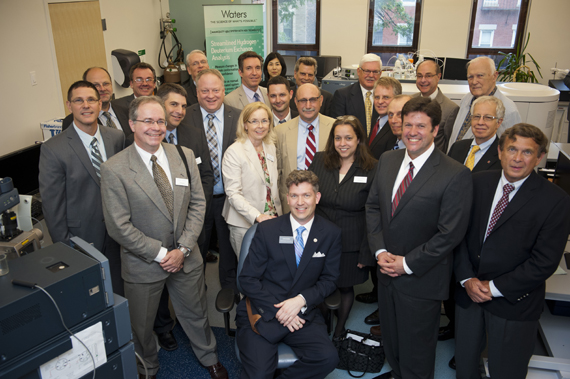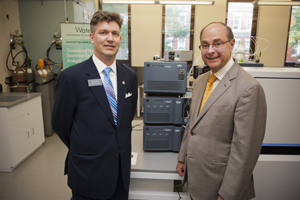Northeastern opens Waters Center of Innovation

Northeastern University hosted a ribbon-cutting ceremony on Wednesday to commemorate the new home of the Waters Laboratory at 140 The Fenway. The lab, designated as a Waters Center of Innovation, is run by John R. Engen, professor of chemistry, and is the cornerstone of the university’s 40-year partnership with the Massachusetts-based Waters Corporation — a world-leading supplier of laboratory analytical instruments.
“We value this partnership tremendously because it is based on the intersection of our interests. But also we value the fact that it has sustained itself for so many years,” Northeastern University President Joseph E. Aoun said at the ceremony. In attendance was university leadership, faculty and top Waters Corporation officials — including Dr. James L. Waters, H’93, who founded the company in 1958 and has long supported Northeastern’s research efforts.

The lab was previously based in Northeastern’s Mugar building. When Engen first brought his ideas to Waters in 2005, he’d been using makeshift instrumentation patched together with random laboratory finds for several years. “He showed slides of a cruddy Styrofoam box!” recalled John Gebler, director of the Waters Centers of Innovation Program.
Engen was steadfast in pushing forward an analytical process — hydrogen-deuterium exchange mass spectrometry (HDX-MS) — that many considered too difficult to be practical. Seven years later, that Styrofoam box has been replaced with a temperature-controlled cooling module in a robotically automated instrument that measures a protein’s dynamic structure in a matter of hours. The instrument has been optimized by Engen and commercialized by Waters.
When used as biopharmaceutical drugs, proteins have applications as far-reaching as treating cancer, HIV/AIDS and stroke. Understanding their conformation can also yield important answers to basic science questions about the way the body operates in health and disease. But they are difficult to characterize: They consist of thousands of atoms, have complex, higher-order structures and are always in flux.
Hydrogen-deuterium exchange provides information about protein structure. In the Styrofoam box days, Engen and his colleagues needed to sift through thousands of pieces of data by hand to get an idea of the protein conformation and dynamics. The process took months.
“If you take a biopharmaceutical drug, wouldn’t you want to know that it wouldn’t hurt you but heal?” asked Gebler. To ensure that a protein is safe and therapeutically active, we need a quick, comprehensive picture of protein conformation. HDX-MS does exactly that.
Prior to the ceremony, Northeastern and the Waters Corporation hosted a symposium for scientists in academia and industry. Murray Gibson, dean of the College of Science, offered opening remarks to kick off the symposium, which highlighted the various ways researchers around the country are using the HDX-MS system for protein drug discovery, characterization and optimization.
Biopharmaceuticals are soon expected to account for half of the top 100 prescribed medications, said Waters CEO Douglas A. Berthiaume. “They offer great promise to patients and can potentially cure disease instead of just treating symptoms.” But more research is required. HDX-MS will most certainly be a critical tool in that effort.
But research is only half the question, Berthiaume continued. “State of the art training is also critical to large molecule characterization and FDA compliance.” Toward that end, Waters and Northestern also announced on Wednesday the development of a biopharmaceutical analytical training lab (BATL) to be housed on Northeastern’s Burlington campus.
A technique that was once carried out by only a handful of analytical chemists is now available to the broader community, answering questions that were thought to have no solution. In 2009, hydrogen-deuterium exchange made the cover of Analytical Chemistry, the seminal journal in measurement science, for the second time, “the equivalent of going double-platinum in the record industry,” said Engen.




